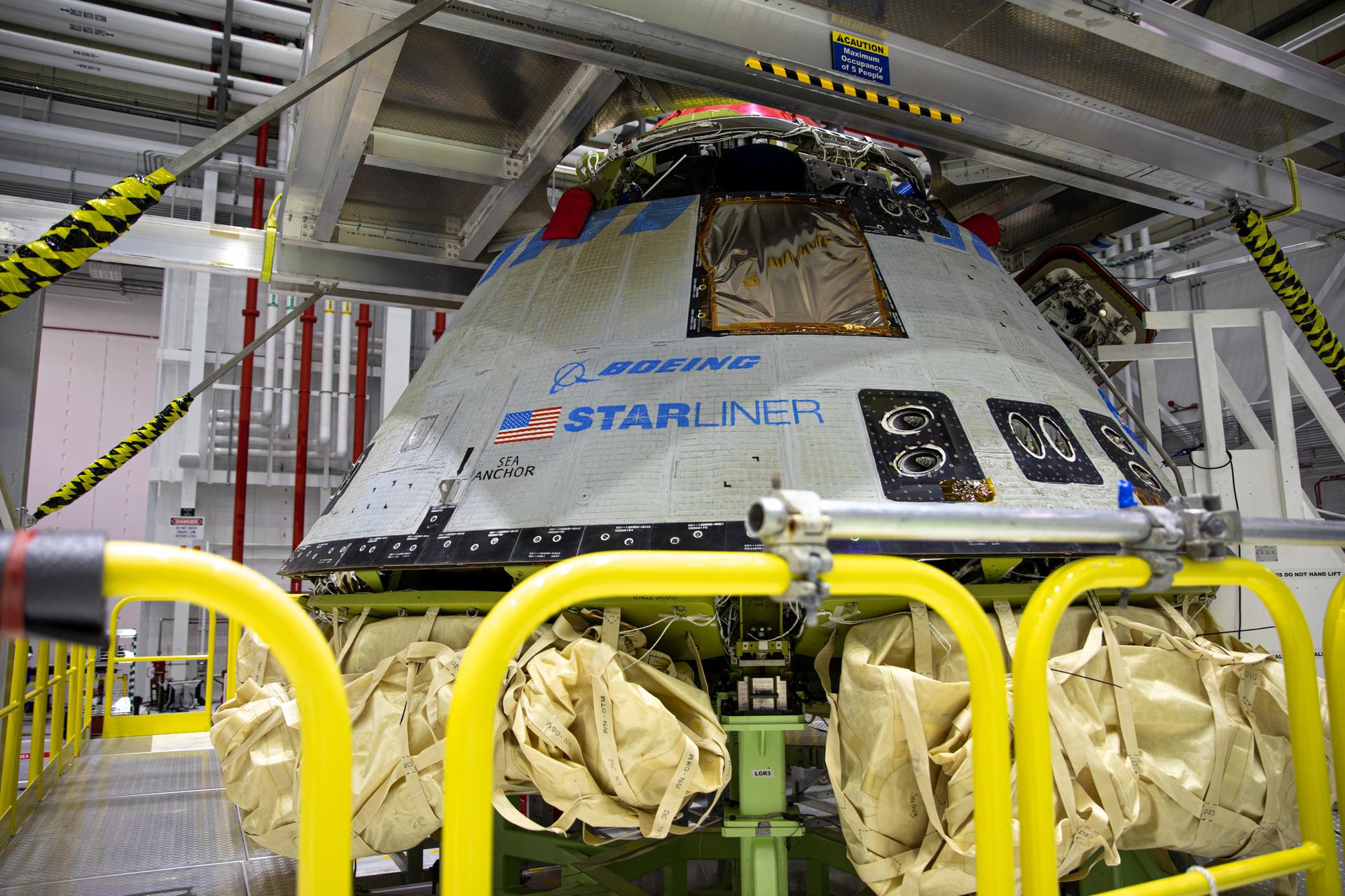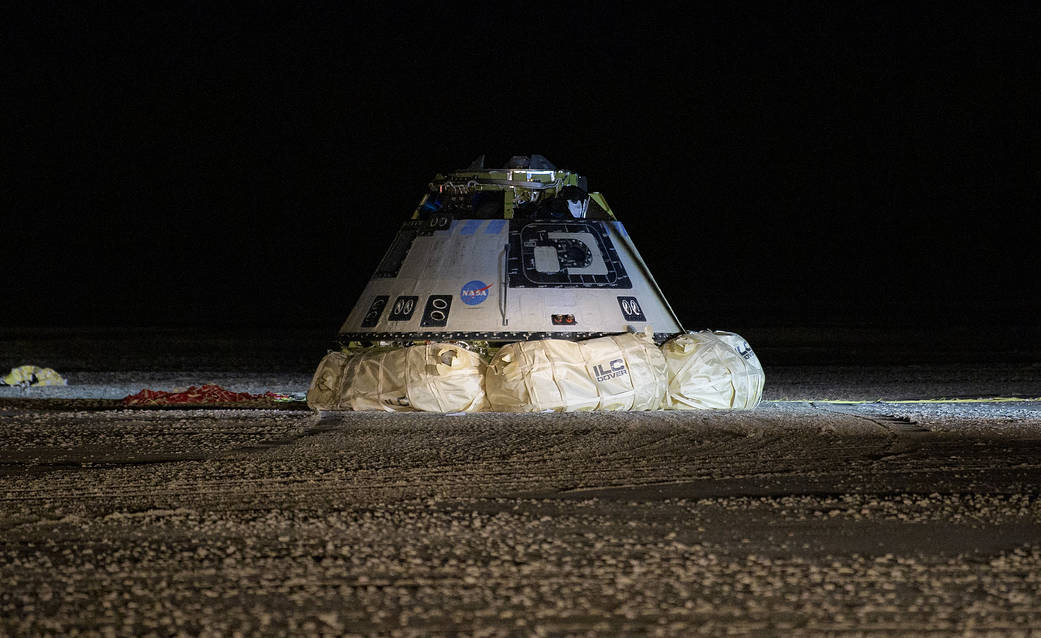NASA could have a timeline for Boeing's next Starliner flight by the end of the month
But the agency doesn't know if it will require Boeing to do a second uncrewed test flight before launching astronauts.

NASA has still not decided whether it will require Boeing to complete a second uncrewed test flight of the company's CST-100 Starliner spacecraft, which failed to reach the International Space Station in its first attempt in December 2019. But the agency may have a game plan ready by the end of the month.
In a teleconference with reporters on Friday (March 6), Kathy Lueders, manager of NASA's Commercial Crew Program, said that NASA is "shooting for the end of the month to have a review between ourselves and Boeing." After making their decision about the best path forward for Boeing's troubled Starliner program, the reviewers will deliver a plan to the head of NASA's Human Exploration and Operations Mission Directorate, Doug Loverro.
However, it could still take a while before NASA can announce when the next Starliner mission will launch — and whether there will be astronauts on board — because NASA and Boeing expect to spend "several months" fixing a myriad of technical problems on Starliner, Loverro added during the teleconference.
Related: Boeing's 1st Starliner flight test in photos
Following Starliner's failure to reach the International Space Station on Dec. 20, a joint NASA-Boeing independent review team identified 61 "corrective actions" to address two major software problems and a communications issue that arose during the mission, called Orbital Flight Test (OFT).
Three big problems
The first problem that became apparent had to do with the spacecraft's on-board timer, which had pulled an incorrect time from the Atlas V rocket on which it launched. Because the so-called "mission elapsed timer" was 11 hours off, Starliner did not complete an orbit insertion burn after launching into space, and that prevented it from completing its mission.
A second critical software problem was identified later on during the flight, shortly before Starliner began to make its way back to Earth for a parachute-assisted landing. A valve-mapping error in the spacecraft's service module could have potentially caused an in-space collision after that disposable part of the spacecraft separated from the crew module.
Get the Space.com Newsletter
Breaking space news, the latest updates on rocket launches, skywatching events and more!
The third major problem was a temporary drop in communications between Starliner and NASA's Tracking and Data Relay Satellites, which transmit data between spacecraft and data stations on Earth. If this communications dropout had not happened, ground controllers could have potentially corrected the timing issue and manually commanded the spacecraft to do its orbit insertion burn. NASA and Boeing are still investigating the cause of this communications issue, which appears to have been radio interference, but Boeing officials have said that it could be solved by replacing Starliner's antenna.
A "high-visibility close call"
Loverro said that NASA is now designating the OFT mission a "high-visibility close call," which the agency defines as an incident during a space mission in which "the potential for a significant mishap could have occurred and should be investigated to understand the risk exposure and the root cause(s) that placed equipment or individuals at risk," according to NASA's Commercial Crew blog.
"We could have lost a spacecraft twice during this mission," Loverro said. "We could have lost it at the beginning of the mission … and we could have lost it at the end of the mission. But thankfully the Boeing guys were able to go through the software and the Johnson [Space Center] guys were able to test it and find the errors. So it's clearly a close call."
While NASA and Boeing have only identified these three specific issues, the review team has come up with a list of 61 corrective actions. That doesn't necessarily mean that there are 61 separate problems with Starliner, Jim Chilton, senior vice president at Boeing Space and Launch, said in the teleconference. Rather, he said the list is of "61 ways to get better in three categories."
When asked if NASA could make that list of 61 corrective actions available to the public, Loverro said, "I don't know. We haven't had that conversation with Boeing, and we'd have to have that conversation."

Next steps
In addition to implementing specific software fixes to address the three critical issues previously disclosed, Boeing has been asked to more broadly improve its engineering and testing procedures for new spacecraft. In the engineering department, NASA has asked Boeing to "strengthen its review process, including better peer and control board reviews, and improve its software process training," according to the NASA blog.
NASA has also asked Boeing to "increase the fidelity in the testing of its software during all phases of flight," and to perform full, end-to-end ground tests during mission simulations — something the company did not do before launching Starliner.
The review team is also looking to identify possible organizational issues that could have contributed to the problems with Starliner. NASA plans to conduct a "organizational safety assessment" while performing an evaluation of the workplace culture at Boeing as well as NASA's Commercial Crew Program.
"We're going to look at both Boeing's organizational processes and NASA's organizational processes in order to go ahead and make sure we truly do learn from this event, and that we know how to fix it and make sure it doesn't happen again," Loverro said.
Boeing was originally scheduled to launch the first crewed test flight of its Starliner spacecraft to International Space Station in the summer of 2020, but that mission has been postponed indefinitely as the company works with NASA to prove that the spacecraft can safely transport astronauts to and from space.
Meanwhile, SpaceX, the other private company that NASA has commissioned to fly astronauts to the space station, is gearing up to launch the first crewed mission of its Crew Dragon spacecraft in May, following a successful uncrewed test flight in March 2019.
- Boeing defends Starliner ground tests after problematic debut flight
- New Boeing video shows Snoopy's ride on Starliner Orbital Flight Test
- 'I can't wait to try it out': starliner's 1st riders welcome capsule back to Earth
Email Hanneke Weitering at hweitering@space.com or follow her @hannekescience. Follow us on Twitter @Spacedotcom and on Facebook.
OFFER: Save at least 56% with our latest magazine deal!
All About Space magazine takes you on an awe-inspiring journey through our solar system and beyond, from the amazing technology and spacecraft that enables humanity to venture into orbit, to the complexities of space science.
Join our Space Forums to keep talking space on the latest missions, night sky and more! And if you have a news tip, correction or comment, let us know at: community@space.com.

Hanneke Weitering is a multimedia journalist in the Pacific Northwest reporting on the future of aviation at FutureFlight.aero and Aviation International News and was previously the Editor for Spaceflight and Astronomy news here at Space.com. As an editor with over 10 years of experience in science journalism she has previously written for Scholastic Classroom Magazines, MedPage Today and The Joint Institute for Computational Sciences at Oak Ridge National Laboratory. After studying physics at the University of Tennessee in her hometown of Knoxville, she earned her graduate degree in Science, Health and Environmental Reporting (SHERP) from New York University. Hanneke joined the Space.com team in 2016 as a staff writer and producer, covering topics including spaceflight and astronomy. She currently lives in Seattle, home of the Space Needle, with her cat and two snakes. In her spare time, Hanneke enjoys exploring the Rocky Mountains, basking in nature and looking for dark skies to gaze at the cosmos.
-
Hari Has NASA acquiesced to the Boeing point of view that a few glitches are no big deal flying crew? No doubt U.S. taxpayers will absorb all of the associated costs for Boeing.Reply










